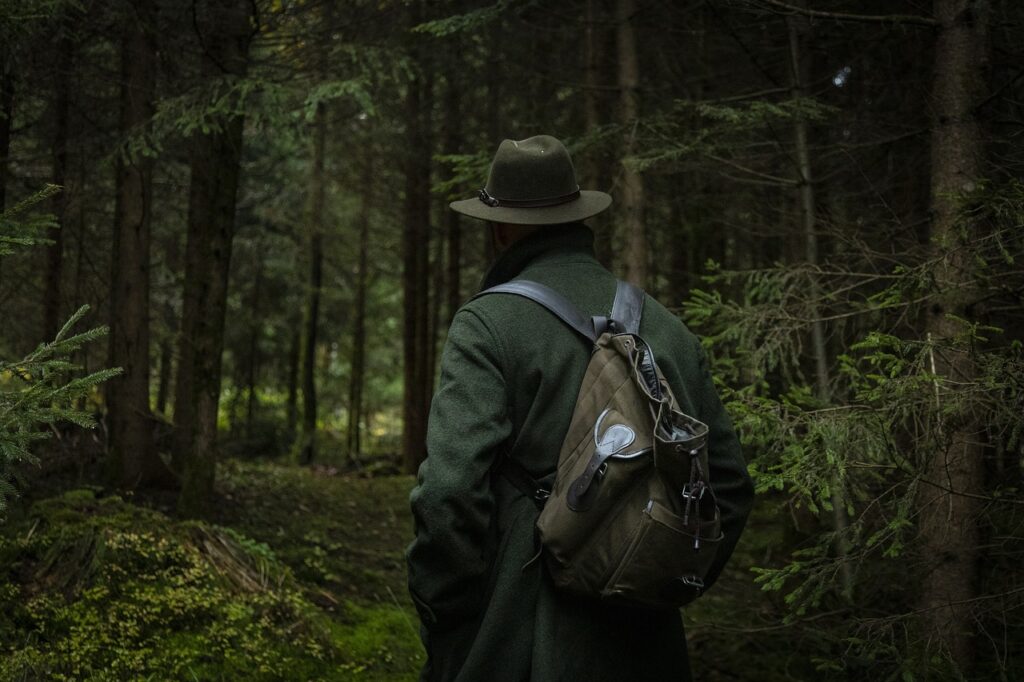Backpacking on a Budget: Top 5 Ultralight Cookware Options for New Hikers
Introduction
Embarking on your first backpacking adventure can feel both exhilarating and overwhelming. You’re eager to explore the wild, but the gear list? It’s long, and the costs can pile up fast. The good news? You don’t need to shell out a fortune to stay light on your feet and fully equipped with backpacking essentials for the trail. If you’re trying to keep your pack light and your wallet even lighter, investing in budget-friendly cookware designed for ultralight hiking gear is a game-changer.
Imagine savoring a warm, hearty meal after a long day of hiking—without the burden of heavy, expensive camping cookware slowing you down. The right backpacking cookware can make or break your outdoor cooking experience, especially when you’re just starting out. In this guide, we’re uncovering the top 5 ultralight cookware options for new hikers that offer the perfect blend of affordability, durability, and trail efficiency. Ready to hit the trail without breaking the bank? Let’s dive in.
What Makes Cookware “Ultralight”?
Understanding Ultralight Standards for Backpackers
When you’re out on the trail, every ounce counts. This is where ultralight hiking gear steps in, offering a sleek, efficient alternative to traditional camping cookware. But what exactly qualifies as “ultralight”? For backpackers, the term refers to gear that’s meticulously designed to be as light as possible without sacrificing function. Generally, ultralight cookware weighs in at less than a pound per set, making it an essential for long-distance hikers who want to minimize their load.
However, it’s not just about weight. True ultralight cookware is compact, packable, and often multi-purpose cookware, allowing you to cook, eat, and clean up with the same piece of gear. These items are carefully engineered to strip away unnecessary features, leaving only what’s crucial for a successful minimalist backpacking experience.
Benefits of Ultralight Cookware for Long Treks
Why does ultralight cookware matter, especially for new hikers? The difference it makes on the trail is astounding. By reducing the weight of your pack, you conserve more energy throughout the day. This translates into less fatigue and a more enjoyable hiking experience overall. Lightweight cooking pots, with their low profile and simple functionality, also take up less space, leaving room for other essentials like food, water, or even luxury items (hello, camp coffee!).
For long-distance hikes, where every ounce saved contributes to stamina, ultralight cookware becomes a necessity, not a luxury. Lightweight gear allows for more nimble movement, fewer pitstops to adjust an overstuffed pack, and a less burdensome setup when it’s time to pitch camp and refuel. It’s the kind of investment that pays dividends over time, allowing you to cover more miles without feeling the strain.
Materials to Look for: Titanium, Aluminum, and More
Not all backpacking cookware is created equal, and the materials used play a critical role in both performance and weight. Titanium cookware is the crown jewel of ultralight gear. Strong, corrosion-resistant, and feather-light, titanium can handle the rigors of outdoor cooking without adding much bulk to your pack. Its only drawback? It tends to be pricier than other options.
Aluminum, especially anodized aluminum pots, is another excellent choice for budget-conscious hikers. It’s lightweight, conducts heat well, and tends to be more affordable than titanium. However, aluminum isn’t as durable as titanium, so it may show signs of wear over time if not properly cared for.
Stainless steel, while durable and affordable, is generally too heavy to fall into the ultralight category. While it’s great for short trips or car camping, it’s not ideal for long-distance treks where weight is a top priority. Instead, look for lightweight options made from a combination of titanium and aluminum, or even collapsible cookware that offers versatility and packability.
In the ultralight world, it’s all about balance—finding the right mix of durability, affordability, and feather-light design. Now that you understand what makes cookware “ultralight,” let’s dive into the top 5 options that meet these criteria while still being budget-friendly cookware.
How to Choose the Right Cookware on a Budget
Key Considerations: Weight, Size, and Price
When shopping for ultralight cookware, three key factors should guide your decision: weight, size, and price. These are the holy trinity of budget-friendly backpacking gear. Let’s break it down.
First, weight is your number one priority. After all, you’re looking for lightweight gear, and the last thing you want is to lug around heavy backpacking pots. Ideally, you want cookware that’s under 10 ounces for a single piece or less than a pound for a full set. Anything heavier, and you’re straying from the ultralight hiking gear path.
Size matters, too. Look for compact camping gear that can nest inside other items or packs down into a small, space-saving bundle. Space in your backpack is precious, and oversized cookware can create a frustrating game of Tetris when trying to pack efficiently. Nesting pots and collapsible cookware are your best bet.
Lastly, price. You don’t need to spend a fortune to get quality gear. In fact, there are plenty of affordable cookware options that balance performance with cost. Aim for budget hiking gear that fits within your budget while still offering the essential features you need. Sure, it’s tempting to go for that high-end titanium cookware set, but anodized aluminum pots or hybrid materials can still serve you well without draining your bank account.
The Importance of Multi-Functionality in Budget Gear
When every ounce and dollar counts, multi-purpose cookware is a lifesaver. The best ultralight cookware isn’t just a pot—it’s a pot, a bowl, a mug, and sometimes even a plate. This kind of versatility can streamline your cooking in the backcountry and reduce the amount of gear you need to carry.
Consider small cookware sets that double as storage, where the lid can be used as a frying pan or the pot can serve as both a cooking vessel and an eating dish. This adaptability can make a big difference on the trail, where simplicity and efficiency are key to a smooth minimalist backpacking experience. Some portable cook sets even come with detachable handles, which not only save space but also add another layer of convenience when packing.
When you’re trying to keep costs low, opting for gear that can do it all is a smart way to maximize value without sacrificing functionality.
Durability vs. Cost: Striking the Right Balance
Backpacking is tough on gear. Your camping cookware will face everything from rough handling to extreme temperatures, so durability is a major consideration—especially if you want your investment to last more than one season. But durability often comes at a price. Higher-end materials like titanium are virtually indestructible but can stretch your budget thin.
If you’re just starting out, striking the right balance between cost and durability is crucial. Look for anodized aluminum pots, which offer a great middle ground. They’re tough enough to handle the demands of outdoor cooking but won’t cost you an arm and a leg. Titanium, though pricier, is worth considering if you anticipate frequent, long-term use. It’s ultra-durable, corrosion-resistant, and incredibly lightweight, making it the gold standard for serious backpackers.
On a budget, however, sometimes it’s smarter to prioritize versatility and weight over extreme durability. As long as you handle your durable camping gear with care, even budget-friendly options can last you multiple trips, giving you a solid return on investment.
Choosing the right backpacking cookware on a budget doesn’t have to be a daunting task. By focusing on weight, size, price, and multi-functionality, you’ll be able to find gear that enhances your backpacking experience without breaking the bank. Now, let’s take a look at the top 5 best budget cookware options for new hikers that meet these criteria perfectly.
Top 5 Budget Ultralight Cookware Options for New Hikers
Overview of the Criteria for Selecting the Top 5
Choosing the right backpacking cookware set for your outdoor adventures can be a game-changer. The key criteria that went into selecting the top 5 options include weight, durability, versatility, and of course, affordability. These are essential factors for lightweight gear that keeps your pack efficient while ensuring you have everything needed to cook and enjoy a satisfying meal after a long day on the trail.
Each of these sets is designed to minimize bulk and weight without compromising on functionality, making them perfect for beginner backpacking tips and experienced hikers alike. Whether you’re after compact camping gear, multi-purpose cookware, or gear that offers superior heat distribution, this list covers all the bases. Let’s break down how these products stack up against each other so you can decide which one is best for you.
Quick Comparison of the Top 5 Options
| Product | Weight | Material | Capacity | Price | Best For |
| TOAKS Titanium 750ml Pot | 3.9 oz | Titanium | 750 ml | ~$27 | Ultralight solo hikers who value durability |
| G4Free 2-Piece Set | 8.2 oz | Aluminum | 1L (Pot), 0.7L (Pan) | ~$20 | Budget-conscious beginners needing versatility |
| Stanley Adventure Cook Set | 7.8 oz | Stainless Steel | 24 oz (709 ml) | ~$15 | Budget campers looking for durability |
| REDCAMP Aluminum Cookware Set | 14.4 oz | Hard-Anodized Aluminum | 1.2L (Pot) | ~$25 | Group hikes or 2-person trips with extra space |
| Snow Peak Trek 700 Titanium | 4.8 oz | Titanium | 700 ml | ~$45 | Long-term hikers seeking an ultra-light option |
1. TOAKS Titanium 750ml Pot
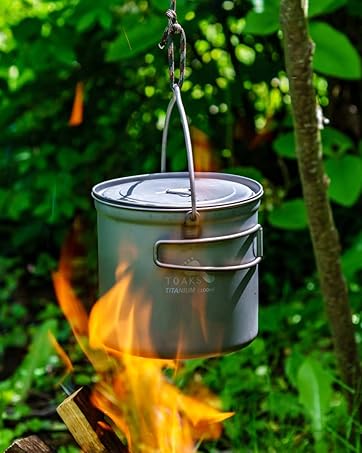
This pot is an ultralight favorite among solo hikers. At only 3.9 ounces, it’s incredibly light and made of corrosion-resistant titanium cookware, which ensures durability even in harsh conditions. The 750ml capacity is just enough for solo meals or boiling water for freeze-dried food. It’s a minimalist backpacking dream, though slightly more expensive compared to other budget-friendly cookware options.
2. G4Free 2-Piece Set
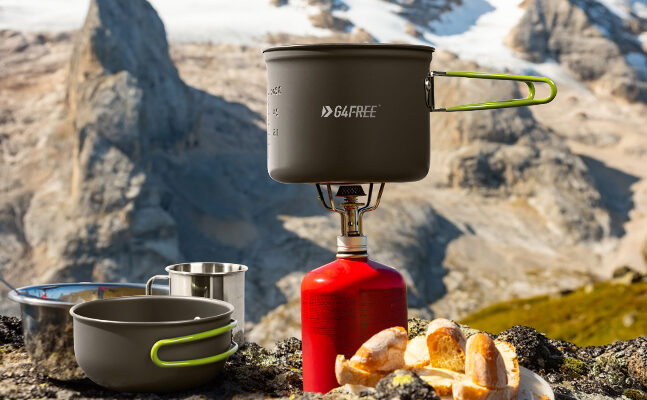
A budget-friendly option that doesn’t skimp on versatility, the G4Free set includes both a pot and a pan, offering more cooking options. Weighing 8.2 ounces combined, this set is perfect for beginners looking to get the most bang for their buck. It’s lightweight, compact, and made from anodized aluminum pots, which are durable enough for regular use without breaking the bank.
3. Stanley Adventure Cook Set
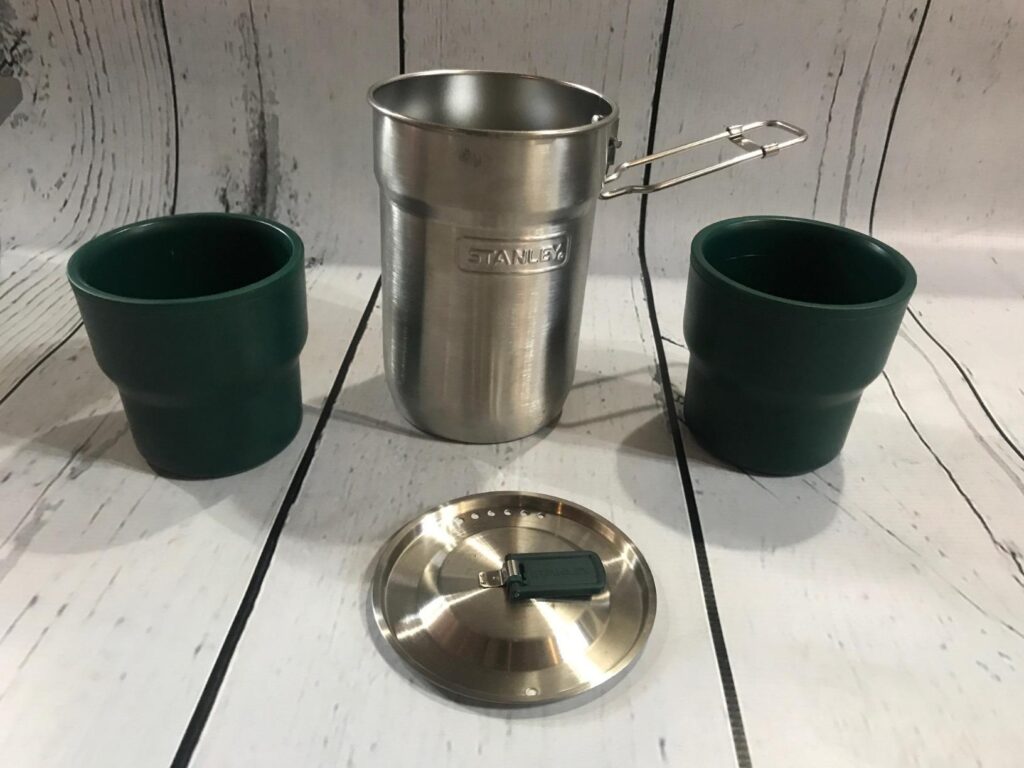
This stainless steel set is perfect for campers who prioritize durability above all else. While slightly heavier at 7.8 ounces, it’s built to last and can handle more abuse than aluminum or titanium cookware. Its 24-ounce capacity makes it suitable for both solo hikers and small groups. Plus, it comes with a built-in handle for easy outdoor cooking over a campfire, making it a solid, budget-friendly cookware choice.
4. REDCAMP Aluminum Cookware Set

The REDCAMP set is ideal for small groups or two-person adventures. With a 1.2-liter capacity, it can accommodate larger meals, and the hard-anodized aluminum offers great heat distribution without adding too much weight. While it’s the heaviest option on this list, at 14.4 ounces, it’s still manageable for short trips or for those willing to carry a bit more for added versatility. Perfect for camping gear for beginners looking for something that balances weight and capacity.
5. Snow Peak Trek 700 Titanium
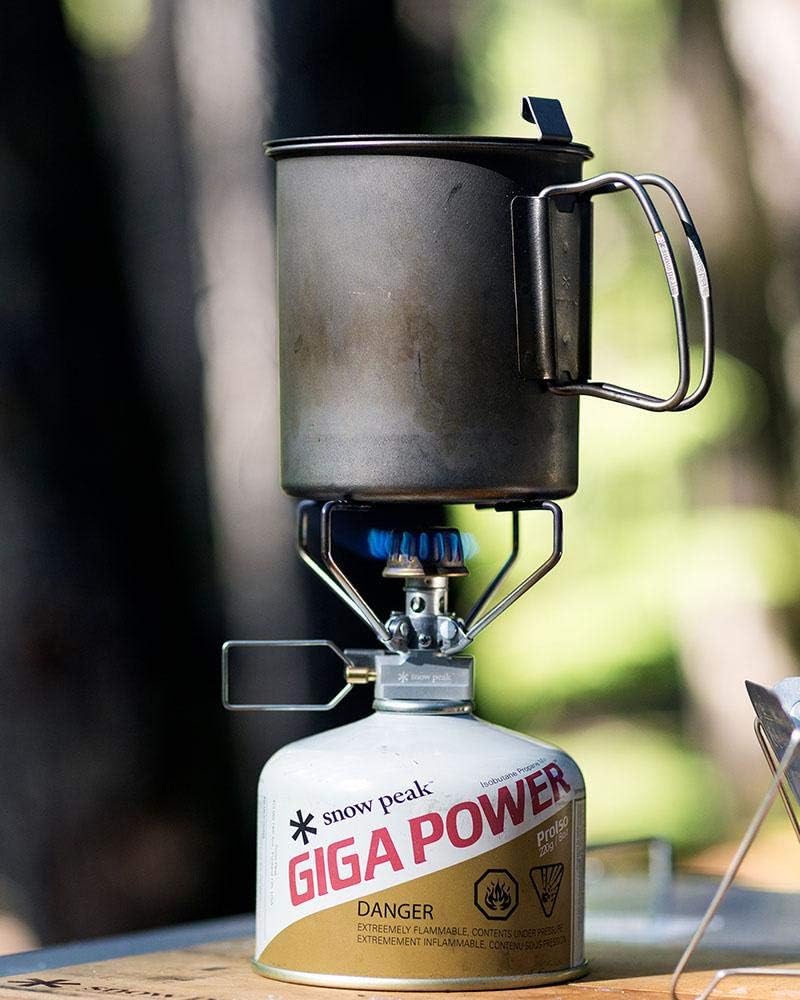
The Snow Peak Trek 700 is another standout for ultralight hikers who don’t want to compromise on quality. Weighing just 4.8 ounces, this titanium pot is strong, corrosion-resistant, and highly packable. While it’s on the pricier side, its lightweight design and 700 ml capacity make it a great investment for those who plan on long-term or frequent backpacking trips.
Each of these cookware options offers something unique to new hikers—whether it’s the ultralight appeal of titanium or the budget-friendly durability of aluminum and stainless steel. Deciding which one is right for you ultimately comes down to how much weight you’re willing to carry and what features matter most for your backpacking cookware needs on your backcountry adventures.
Pros and Cons of Top 5 Budget Ultralight Cookware Options for New Hikers
| Product | Pros | Cons |
| TOAKS Titanium 750ml Pot | – Ultra-light (3.9 oz)- Durable titanium | – Higher price- Small capacity |
| G4Free 2-Piece Set | – Affordable- Versatile (pot and pan combo) | – Heavier (8.2 oz)- Less durable than titanium |
| Stanley Adventure Cook Set | – Very affordable- Durable stainless steel | – Heavier (7.8 oz)- Limited capacity |
| REDCAMP Aluminum Cookware Set | – Large capacity- Affordable | – Heaviest (14.4 oz)- Bulky for solo hikers |
| Snow Peak Trek 700 Titanium | – Ultralight (4.8 oz)- High-quality titanium | – Expensive- Small capacity (700 ml) |
How to Care for Your Ultralight Cookware
Proper care and maintenance of your ultralight cookware will ensure it serves you well for years to come. These lightweight pieces are designed to endure rugged outdoor conditions, but a little extra care goes a long way. Whether you’re scrubbing off the remains of last night’s dinner or packing your gear for the next adventure, these tips will help you keep your backpacking cookware in top shape.
Cleaning Tips to Extend the Life of Your Gear
- Avoid Harsh Scrubbers: Titanium, aluminum, and stainless steel are durable, but using abrasive scrubbers can wear down the surfaces over time. Instead, opt for a soft sponge or cloth.
- Use Biodegradable Soap: When washing dishes in the wild, use biodegradable soap to protect the environment. A little soap goes a long way with lightweight cookware, and it’s gentle on the materials.
- Pre-soak for Stubborn Stains: If food is stubbornly stuck on, soak the pot or pan in warm water for a few minutes before scrubbing. This loosens food residue and makes cleaning easier without damaging the cookware.
- Dry Immediately: After cleaning, make sure to dry your cookware completely before storing it. This prevents rust, especially in aluminum or steel cookware, and keeps everything ready for the next trip.
Storage and Packing Hacks for the Trail
- Nest Your Cookware: Most ultralight cookware is designed to nest, saving space in your pack. Stack pots, pans, and cups inside one another, and if your cookware comes with a mesh bag, use it to keep everything together.
- Store Small Items Inside: Use the empty space inside your backpacking pots to store smaller items, such as your hiking stove, utensils, or food packets. This maximizes space efficiency and protects your cookware from dents.
- Pack It High in Your Bag: Keep your cookware near the top of your backpack, where it’s easy to access when you stop for a meal. It also helps distribute weight more evenly for a balanced pack.
- Use a Protective Cloth: To prevent scratches and wear, wrap your cookware in a bandana or lightweight cloth before packing. This not only protects the gear but also gives you an extra multi-functional item for the trail.
Common Mistakes to Avoid
- Overheating the Cookware: Titanium and aluminum heat quickly, so avoid leaving cookware unattended over a high flame. Overheating can warp or damage even the toughest cookware, and ruin your meal.
- Skipping the Drying Step: Leaving cookware damp before packing can lead to rust (in stainless steel) or bacterial growth (in all types of cookware). Make sure everything is thoroughly dried before storing.
- Forgetting to Pack a Lid: Lids aren’t just for keeping food warm—they save cooking time and fuel by trapping heat. Make sure to pack a lid, even if it doubles as a plate, for better efficiency on the trail.
- Not Cleaning Immediately: It can be tempting to skip dish duty after a long day, but cleaning your cookware as soon as possible prevents food from hardening and keeps your gear in good condition for the next use.
With these simple care techniques, your ultralight cookware will stay in great shape and continue to serve you on countless outdoor adventures. By keeping your gear clean, well-packed, and handled with care, you’ll maximize its longevity and performance on the trail.
Bonus Tips for Cooking in the Backcountry
Cooking in the backcountry doesn’t have to be complicated. With a bit of planning and the right approach, you can enjoy satisfying meals without hauling heavy gear or supplies. Here are a few tips to help beginner backpackers make the most of their ultralight cookware while enjoying simple, tasty meals on the trail.
Simple, Lightweight Meals for Beginner Backpackers
When it comes to backcountry meals, simplicity is key. You’ll want food that’s lightweight, quick to prepare, and packed with energy to keep you fueled. Here are a few trail-friendly meal ideas that won’t weigh you down:
- Instant Noodles: A classic for a reason. Lightweight, easy to pack, and requires only boiling water to prepare. Add a few packets of soy sauce or hot sauce to spice things up.
- Oatmeal: Pre-packaged oatmeal packets make for an ideal breakfast. Just add hot water and mix. You can also boost the flavor by adding nuts, dried fruit, or powdered milk.
- Dehydrated Meals: Many outdoor brands offer freeze-dried or dehydrated meals that are both lightweight and calorie-dense. Simply add boiling water, stir, and enjoy.
- Couscous or Instant Rice: Both couscous and instant rice cook quickly and serve as a base for other ingredients like dried vegetables or small packets of tuna.
- Trail Mix Wraps: For a no-cook option, pack tortillas, peanut butter, and a mixture of dried fruits and nuts. It’s simple, delicious, and requires zero cookware.
How to Maximize Efficiency with Limited Cookware
When you’re carrying minimal backpacking cookware, efficiency becomes essential. Here are some ways to make the most of your gear on the trail:
- One-Pot Meals: Cook everything in one pot. Combine your carbs, protein, and veggies into a single dish to cut down on cleaning time and save fuel. For example, mix instant noodles with dried vegetables and jerky for a hearty meal.
- Boil Water First: If your meal requires both boiling water and cooking ingredients, always boil the water first. This allows you to use some for hot drinks while the rest goes toward cooking your food.
- Use Your Pot Lid: Using a lid while cooking helps trap heat, allowing your meal to cook faster while conserving fuel. Lids can also double as makeshift plates or even frying surfaces if needed.
- Rehydrate on the Go: Soak dried ingredients like beans or lentils in water while you hike. By the time you’re ready to cook, they’ll be partially hydrated, reducing your cooking time and saving fuel.
Food Prep Tips to Save Time and Reduce Weight
Saving time and cutting down on pack weight starts with smart meal prep before you even hit the trail. Here’s how to get organized:
- Pre-Portion Ingredients: Measure out portions of pasta, rice, oats, or spices and pack them into small resealable bags. This reduces bulk and saves time when cooking.
- Dehydrate Your Own Meals: If you’re feeling ambitious, invest in a food dehydrator and prepare your own lightweight meals. Dehydrating homemade soups, stews, or chili is an excellent way to pack flavorful, nutritious food without the weight.
- Minimize Packaging: Remove all unnecessary packaging before you leave. Repack items like instant oatmeal or snacks into reusable bags to save space and weight.
- Opt for High-Calorie Foods: Focus on packing foods that deliver a high calorie-to-weight ratio. Nuts, seeds, olive oil, and cheese provide plenty of energy without adding excessive weight.
- Double Up on Ingredients: Bring ingredients that can be used in multiple meals. For example, powdered milk can be added to both oatmeal in the morning and instant mashed potatoes at dinner.
By following these tips, you can create delicious, energy-packed meals in the backcountry without overloading your pack. With the right planning, even beginner backpackers can eat well on the trail while keeping things light and easy.
How Much Should You Spend on Your First Cookware Set?
Finding the Sweet Spot Between Budget and Quality
When you’re gearing up for your first backpacking adventure, it’s tempting to go for the cheapest gear you can find. But while keeping costs down is important, skimping too much on quality can lead to frustrating experiences in the wilderness. The goal is to find that perfect balance between affordability and functionality, ensuring that your backpacking cookware will serve you well without leaving a gaping hole in your wallet.
A good range to aim for with beginner ultralight cookware is between $20 and $50. In this price range, you’ll find plenty of solid, budget-friendly cookware options made from lightweight materials like anodized aluminum or titanium cookware. These products offer durability and packability, while still being easy on your budget. Keep in mind, though, that the cheapest cookware may not last as long or perform as well under tougher conditions. Opting for mid-range items allows you to enjoy more reliable gear without overcommitting financially.
How Much is Too Much? When to Invest in Premium Gear
For beginners, spending hundreds of dollars on top-of-the-line titanium cookware is overkill. Premium gear is great, but it’s not always necessary for those who are just starting out. However, as you gain more experience and take on longer, more challenging hikes, investing in higher-quality cookware can be worth it.
So, how do you know when it’s time to upgrade? Here are a few signs:
- You’re planning long-distance treks: If you’re committing to multi-day, backcountry hikes, premium gear may become more important. Durability and weight savings can make a significant difference over time.
- Your current gear is wearing out: If your budget cookware has served its purpose but is starting to show signs of wear and tear, it might be worth considering an upgrade. Durable, premium cookware made from titanium will last longer and can handle more extreme conditions.
- You value weight savings: Ultralight enthusiasts who are willing to pay a premium for gear that shaves off every last ounce may find it worthwhile to invest in high-end cookware. In the ultralight world, titanium pots, for example, are a staple for those looking to cut down on every gram.
For most new hikers, sticking to the budget-friendly options highlighted earlier is a smart move. You can always upgrade your gear later, as your needs and experience evolve. Remember, the best cookware is the one that meets your specific needs without compromising your comfort on the trail—or your budget.
Where to Find the Best Deals on Ultralight Cookware
When you’re a new hiker on a budget, finding the best deals on ultralight cookware can feel like a treasure hunt. Luckily, there are plenty of ways to save money on quality gear without compromising on performance. Whether you’re scouring the internet for a bargain or waiting for the perfect moment to pounce on a sale, here’s how to score great deals on backpacking cookware that won’t break the bank.
Online Marketplaces and Discount Outdoor Stores
Shopping online opens up a world of options for budget-conscious hikers. Major retailers like Amazon, REI, and Backcountry often offer a wide range of camping cookware sets at competitive prices. The key is to be patient and keep an eye on fluctuating prices—many websites have daily deals or limited-time offers. Price comparison tools or browser extensions can also help you track price changes and alert you when a product drops into your ideal range.
Discount outdoor stores like Steep & Cheap or Sierra are another excellent resource for snagging top brands at a fraction of their original price. These sites often carry overstocked or previous-season items, meaning you can score high-quality gear without paying full retail. Just make sure to check product reviews and specs to ensure you’re getting reliable, lightweight cookware.
Timing Your Purchase: Sales and Seasonal Discounts
Timing is everything when it comes to buying ultralight cookware at a great price. Certain times of the year, like end-of-season sales or holiday events, are perfect for getting the gear you need at a discount. Here are a few occasions to watch for:
- End-of-season sales: As summer wraps up and outdoor retailers prepare for the colder months, they often discount camping gear for beginners and hikers. This is a great time to grab backpacking cookware at reduced prices.
- Black Friday and Cyber Monday: These shopping events offer huge discounts across the board. Many outdoor retailers take part, slashing prices on camping cookware, including portable cook sets.
- Spring sales: Just before the hiking season kicks off, many stores offer pre-season sales to help backpackers gear up. Keep an eye on major retailers from late February through April for deals on ultralight hiking gear.
By planning your purchases around these sales, you can maximize savings and still get high-quality cookware for your backpacking adventures.
Second-Hand Gear: A Viable Option for Budget-Conscious Hikers
For those looking to cut costs even further, second-hand gear can be an excellent option. Platforms like eBay, GearTrade, or even local outdoor forums often feature used ultralight cookware in great condition. Buying second-hand can reduce costs by 30% or more, allowing you to snag higher-end items like titanium cookware without paying premium prices.
When buying second-hand, however, it’s important to inspect the item (or the listing photos) carefully. Look for signs of wear, such as dents or scratches, especially on cookware surfaces. Make sure that handles and other detachable parts are included and functional. Many sellers are seasoned hikers themselves and take great care of their gear, so don’t hesitate to ask questions before purchasing.
Additionally, checking out local outdoor gear shops or community yard sales can lead to unexpected finds. You may even connect with other hikers who are looking to upgrade their gear and willing to sell their used backpacking cookware at a fair price.
In short, there’s no need to pay full price to enjoy quality ultralight cookware. By exploring online marketplaces, keeping an eye on sales, and considering second-hand options, you can find reliable gear that fits both your pack and your budget.
Conclusion
Why Budget Ultralight Cookware is Ideal for New Backpackers
Starting out in the world of backpacking can feel overwhelming, especially when it comes to choosing the right gear. But the beauty of ultralight cookware is that it doesn’t have to cost a fortune to be effective. Budget-friendly cookware options allow new backpackers to stay light on the trail without sacrificing performance. Whether you’re preparing a simple, hearty meal after a long day of hiking or boiling water for a quick cup of coffee at sunrise, ultralight cookware delivers efficiency without adding unnecessary weight to your pack. Plus, with so many great options available at affordable prices, there’s no need to overspend to enjoy the benefits of modern, lightweight gear.
Final Thoughts on Making the Right Purchase for Your Adventure
Choosing the right backpacking cookware boils down to your personal needs and budget. For those looking for durability and minimal weight, titanium options like the TOAKS 750ml Pot or Snow Peak Trek 700 are excellent choices. On the other hand, aluminum sets like the G4Free or REDCAMP offer versatility at a fraction of the cost, making them perfect for beginners and budget-conscious hikers. The Stanley Adventure Cook Set stands out for its durability and unbeatable price, especially for casual weekend trips or car camping.
Ultimately, it’s about finding that sweet spot where weight, functionality, and affordability intersect. There’s no perfect answer—only the best choice for your specific needs.
Encouragement to Get Out and Start Your First Backpacking Trip
Now that you’ve got the basics on budget ultralight cookware, the only thing left to do is get out there and start your adventure! The trail is waiting, and with the right gear in your pack, you’ll be ready to embrace the beauty of the outdoors without being weighed down. Whether you’re tackling your first-weekend trek or planning an epic multi-day journey, having the right cookware in your pack will make those meals in the wild all the more enjoyable.
Don’t overthink it. Choose the cookware that fits your style, hit the trail, and savor every moment. The backcountry has so much to offer—both in terms of adventure and the joy of simple, satisfying meals under the open sky.
This post may contain affiliate links which means I may receive a commission for purchases made through links. I will only recommend products that I have personally used!

